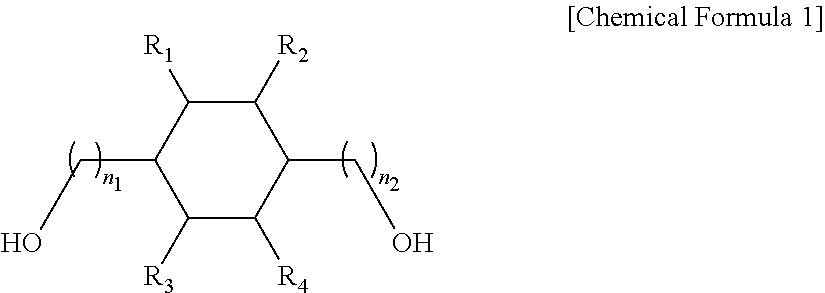Parts for automobiles, electrical/electronic devices, home appliances, office equipment, or daily necessities
a technology for electrical/electronic devices and parts, applied in the direction of automobile parts, electrical/electronic devices, home appliances, or daily necessities, can solve the problems of low heat resistance of polycarbonate, inability to meet the needs of customers, etc., to improve the impact resistance and heat resistance, and improve the effect of chemical resistan
- Summary
- Abstract
- Description
- Claims
- Application Information
AI Technical Summary
Benefits of technology
Problems solved by technology
Method used
Image
Examples
example 1
[0114]0.5 wt % of acrylonitrile-styrene-glycidyl methacrylate, 0.2 wt % of a phenolic primary antioxidant, and 0.2 wt % of a phosphite-based secondary antioxidant were added, based on 100 wt % of a resin consisting of 60 wt % of a terephthalic acid-isosorbide-1,4-cyclohexanediol-ethylene glycol copolymer polyester (Tg: 120° C., weight average molecular weight: 50,000), 10 wt % of an acrylonitrile-butadiene-styrene graft copolymer, 5 wt % of a methyl methacrylate-butadiene-styrene graft copolymer, and 25 wt % of polycarbonate, and kneading extrusion was uniformly carried out using a twin-screw kneading extruder (Φ: 40 mm, L / D=40) so as to prepare a pellet.
[0115]In this regard, the terephthalic acid-isosorbide-1,4-cyclohexanediol-ethylene glycol copolymer polyester was an environmentally friendly resin having high impact resistance, ECOZEN available from SK Chemicals (Korea), the acrylonitrile-butadiene-styrene graft copolymer was HR-181 which is the graft ABS product in the form of a...
example 2
[0116]0.5 wt % of acrylonitrile-styrene-glycidyl methacrylate, 0.2 wt % of a phenolic primary antioxidant and 0.2 wt % of a phosphite-based secondary antioxidant were added, based on 100 wt % of a resin consisting of 50 wt % of a terephthalic acid-isosorbide-1,4-cyclohexanediol-ethylene glycol copolymer polyester (Tg: 120° C., weight average molecular weight: 50,000), 15 wt % of an acrylonitrile-butadiene-styrene graft copolymer, and 35 wt % of a polycarbonate, and kneading extrusion was uniformly carried out using a twin-screw kneading extruder (Φ: 40 mm, L / D=40) so as to prepare a pellet.
[0117]In this regard, the terephthalic acid-isosorbide-1,4-cyclohexanediol-ethylene glycol copolymer polyester was an environmentally friendly resin having high impact resistance, ECOZEN available from SK Chemicals (Korea), the acrylonitrile-butadiene-styrene graft copolymer was HR-181 which is the graft ABS product in the form of a core-shell rubber available from Kumho Petrochemical (Korea), the...
example 3
[0118]0.5 wt % of acrylonitrile-styrene-glycidyl methacrylate, 0.2 wt % of a phenolic primary antioxidant, and 0.2 wt % of a phosphite-based secondary antioxidant were added, based on 100 wt % of a resin consisting of 40 wt % of a terephthalic acid-isosorbide-1,4-cyclohexanediol-ethylene glycol copolymer polyester (Tg: 110° C., weight average molecular weight: 55,000), 15 wt % of a acrylonitrile-butadiene-styrene graft copolymer, and 45 wt % of a polycarbonate, and kneading extrusion was uniformly carried out using a twin-screw kneading extruder (Φ: 40 mm, L / D=40) so as to prepare a pellet.
[0119]In this regard, the terephthalic acid-isosorbide-1,4-cyclohexanediol-ethylene glycol copolymer polyester was an environmentally friendly resin having high impact resistance, ECOZEN available from SK Chemicals (Korea), the acrylonitrile-butadiene-styrene graft copolymer was HR-181 which is the graft ABS product in the form of a core-shell rubber available from Kumho Petrochemical (Korea), the...
PUM
| Property | Measurement | Unit |
|---|---|---|
| glass transition temperature | aaaaa | aaaaa |
| glass transition temperature | aaaaa | aaaaa |
| particle diameter | aaaaa | aaaaa |
Abstract
Description
Claims
Application Information
 Login to View More
Login to View More - R&D
- Intellectual Property
- Life Sciences
- Materials
- Tech Scout
- Unparalleled Data Quality
- Higher Quality Content
- 60% Fewer Hallucinations
Browse by: Latest US Patents, China's latest patents, Technical Efficacy Thesaurus, Application Domain, Technology Topic, Popular Technical Reports.
© 2025 PatSnap. All rights reserved.Legal|Privacy policy|Modern Slavery Act Transparency Statement|Sitemap|About US| Contact US: help@patsnap.com



